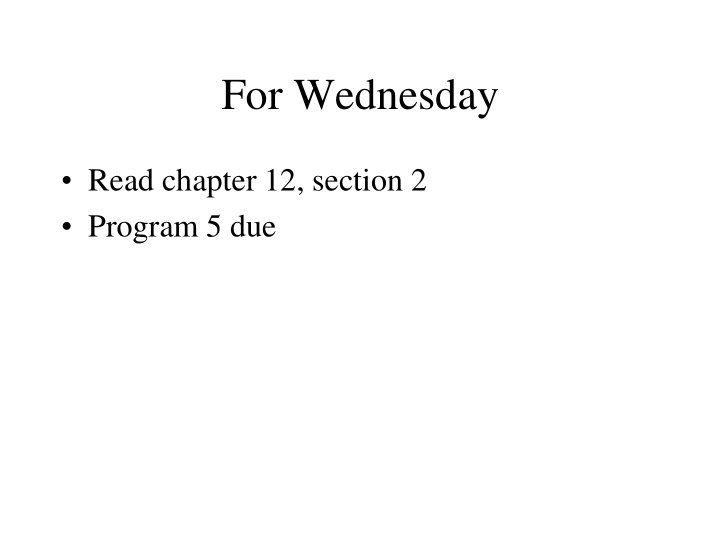



For Wednesday • Read chapter 12, section 2 • Program 5 due
Program 5 • Any questions?
Research Paper • Any questions?
Linear Congruential Generators • Basic concept: – x i +1 = A x i mod M • First x must be given: cannot be 0. • Quality of the generator depends on the selection of A and M. • If M is prime, x i is never 0. • Need to handle arithmetic overflow. • PS: Standard rand() is not this good.
Skip Lists
Problem Solving as Search • Many problems have a solution space that can easily be thought of as a directed graph or a tree • We can solve problems of this type by searching for the optimal solution in the space of possible solutions (the solution space)
Implicit Trees/Graphs • Note that we do NOT have to construct the graph of the entire solution space • We only need a procedure for finding the next set of nodes
Backtracking • Essentially, depth-first search in a solution space which can be represented as a directed graph • When we discover that the current node does not produce the solution we want, we backtrack to a node where we can make an alternate decision and proceed from there
Backtracking Method Steps • Define the solution space • Organize the space appropriately to search in • Search depth-first using bounding functions to avoid searching uninteresting parts of the space
Applications
Bounding Functions • We need to recognize infeasible solutions • We need to recognize bad solutions
N-Queens • Placing a set of N queens on an NxN board such that no two queens are attacking each other.
Game Playing Problem • Instance of general search problem • States where game has ended are terminal states • A utility function (or payoff function) determines the value of the terminal states • In 2 player games, MAX tries to maximize the payoff and MIN is tries to minimize the payoff • In the search tree, the first layer is a move by MAX and the next a move by MIN, etc. • Each layer is called a ply
Minimax Algorithm • Method for determining the optimal move • Generate the entire search tree • Compute the utility of each node moving upward in the tree as follows: – At each MAX node, pick the move with maximum utility – At each MIN node, pick the move with minimum utility (assume opponent plays optimally) – At the root, the optimal move is determined
Recursive Minimax Algorithm function Minimax-Decision( game ) returns an operator for each op in Operators[ game ] do Value[ op ] <- Mimimax-Value(Apply( op , game ), game ) end return the op with the highest Value[ op ] function Minimax-Value( state , game ) returns a utility value if Terminal-Test[ game ]( state ) then return Utility[ game ]( state ) else if MAX is to move in state then return highest Minimax-Value of Successors( state ) else return lowest Minimax-Value of Successors( state )
Making Imperfect Decisions • Generating the complete game tree is intractable for most games • Alternative: – Cut off search – Apply some heuristic evaluation function to determine the quality of the nodes at the cutoff
Evaluation Functions • Evaluation function needs to – Agree with the utility function on terminal states – Be quick to evaluate – Accurately reflect chances of winning • Example: material value of chess pieces • Evaluation functions are usually weighted linear functions
Alpha-Beta Pruning • Concept: Avoid looking at subtrees that won’t affect the outcome • Once a subtree is known to be worse than the current best option, don’t consider it further
General Principle • If a node has value n, but the player considering moving to that node has a better choice either at the node’s parent or at some higher node in the tree, that node will never be chosen. • Keep track of MAX’s best choice ( ) and MIN’s best choice ( ) and prune any subtree as soon as it is known to be worse than the current or value
function Max-Value (state, game, , ) returns the minimax value of state if Cutoff-Test(state) then return Eval(state) for each s in Successors(state) do <- Max( , Min-Value(s , game, , )) if >= then return end return function Min-Value(state, game, , ) returns the minimax value of state if Cutoff-Test(state) then return Eval(state) for each s in Successors(state) do <- Min( ,Max-Value(s , game, , )) if <= then return end return
Recommend
More recommend